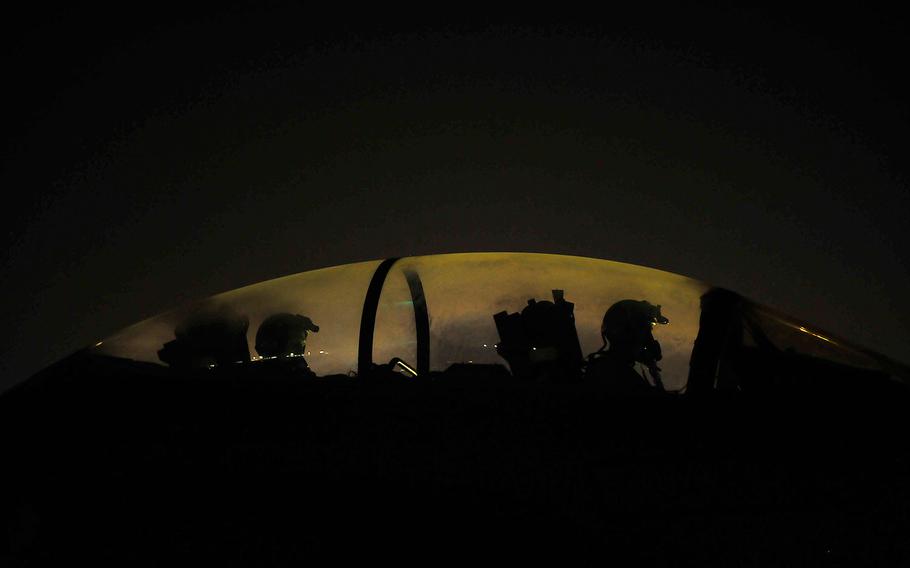
An F-15E Strike Eagle waits to launch in the U.S. Central Command area of responsibility prior to strike operations in Syria Sept. 23, 2014. These aircraft were part of a large coalition strike package that was the first to strike ISIL targets in Syria. (U.S. Air Force photo by Tech. Sgt. Russ Scalf) (U.S. Air Forces Central Command )
WASHINGTON — U.S. jets and drones conducted more than 20 airstrikes against al-Qaida targets in Yemen on Thursday, roughly one month after U.S. special operators carried out a raid in the same province that led to the death of a Navy SEAL, Pentagon officials said.
The strikes, which were conducted overnight in a mountainous region where the provinces of Bayda, Shabwa and Abyan converge, targeted buildings, weapon systems, fighters and equipment along Yemen’s southern coastal area, Navy Capt. Jeff Davis, a Pentagon spokesman, said in a statement.
The region has been used by al-Qaida in the Arabian Peninsula as a hideout, and the strikes killed at least four militants, according to Yemeni officials in a report by The Associated Press.
“The strikes will degrade [al-Qaida’s] ability to coordinate external terror attacks and limit their ability to use territory seized from the legitimate government of Yemen as a safe space for terror plotting,” Davis said.
Thursday’s airstrikes come after U.S. special operations forces carried out a raid Jan. 29 in which Navy SEAL Chief Petty Officer William “Ryan” Owens was killed, four other U.S. servicemembers were wounded and a military aircraft was destroyed after it crash-landed. The attack was launched just days after President Donald Trump’s inauguration.
It was not clear Thursday whether intelligence captured in the Jan. 29 raid led to Thursday’s airstrikes, or if this was the first operation against the terrorist group in Yemen since that operation. A U.S. defense official who spoke on the condition of anonymity said the Pentagon is not required to announce every strike conducted in Yemen.
The defense official said the Defense Department, as instructed by President Barack Obama’s administration, is not required to announce strikes outside of “areas of active hostility.” Yemen, Libya, Pakistan and Somalia are considered outside those areas, the official said.
“We have not announced all strikes in Yemen,” the official said.
Al-Qaida has seized large swaths of land in Yemen and entire cities starting in 2011 with the mass uprising that ended with the ouster of longtime ruler Ali Abdullah Saleh in 2012.
However, the group grew in weapons and numbers after the start of the 2015 Saudi-led campaign that targeted Houthi rebels who had seized control of the capital Sanaa, forcing the internationally recognized government to flee the country. Since then, the war exasperated the state of lawlessness and gave al-Qaida freedom of movement and recruitment.
The group has also emerged as a de facto ally of the U.S.-backed Abed Rabbo Mansour Hadi and his backers -- Saudi Arabia and the United Arab Emirates -- against the Shiite rebels. The United States has also supported the oil-rich Saudi Arabia with military advisers, logistics and intelligence in addition to billions of dollars in arms.
Throughout the years, the United States has depended on drone strikes to hunt down al-Qaida’s top leaders and operatives. In 2015, the group’s leader was killed in a drone strike in the southern city of Mukalla, which had fallen into the hands of al-Qaida for a year.
The Associated Press contributed to this story.
Copp.Tara@stripes.com Twitter:@TaraCopp